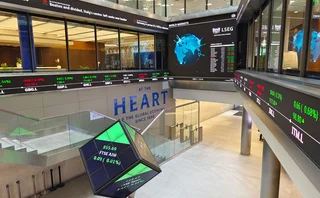
OTC trading platform of the year: Tradeweb
Risk Awards 2023: Traders prized the platform’s convenience and flexibility during last year’s market turbulence

A familiar grumble about electronic venues is that – when things get rough – traders reach for the safety of the phone, seeking more colour, more certainty, and the comfort of a battle-tested relationship. But 2022 was different. In some cases, users found the electronic route produced better results than calling up a dealer.
Take the frequent periods of turmoil in the rates market as an example, when the relationship between different products – or even different points on the same interest rate curve – suddenly decoupled from historic norms. On the face of it, this would have been precisely the time to phone a bank desk. A trader at one European asset manager tried it, when the correlation between three-month and six-month Euribor broke down. But the trader was left disappointed.
“Banks assumed correlations couldn’t go beyond a particular threshold. But then all of a sudden they did, and traders had to get management sign-off to close positions and take a loss,” the trader says.
Despite friction with individual dealers, the trader found executing interest rate swaps on Tradeweb “was seamless and user-friendly”.
Or take the September mayhem in UK government bonds, sparked by the short-lived Truss administration’s so-called “mini-budget”. Pension funds with a liability-driven investing (LDI) strategy found themselves in the crosshairs, as yields and margin calls soared. Managing that episode required quick-fire trading in a host of different instruments, including gilts, interest rate swaps and repo.
Tradeweb allows users to execute these trades in multi-asset packages, which helped drive a sharp rise in volumes on the platform, according to Enrico Bruni, head of Europe and Asia business at the firm. For the third quarter as a whole, gilt notionals at Tradeweb jumped 34% when compared to the same period in 2021.
“The mini-budget episode shows how important it is to have a multi-asset offering for LDIs,” says Bruni.
And take the shock to the credit markets immediately after Russia’s invasion of Ukraine last February. Bruni says traded volumes of fixed income ETFs and credit default swap indexes “really picked up” in February and March on Tradeweb, as market participants embraced electronic trading rather than fleeing it.
“When a crisis of this magnitude occurs, not only do clients not switch off electronic, they are now turning to electronic channels to help them navigate credit markets, significantly minimising execution risk and operational risk,” says Bruni.
That hasn’t always been the case. During the early stages of the Covid-19 pandemic, buy-siders reported a dearth of bond liquidity on the likes of MarketAxess and Tradeweb. Bruni acknowledges that in crisis periods last year, liquidity on the venue dwindled due to uncertainty in rates markets and political factors. That translated into longer times to quote, reduced hit and quote ratios.
But, he says, the difference now is that two years of pandemic remote working have helped “solidify the behavioural change” of accessing liquidity via electronic venues.
Manual versus automatic
One area where this behavioural change is evident is in Tradeweb’s AiEX service. AiEX allows clients to automate some elements of execution for smaller transactions, freeing up the trader for big-ticket items that would benefit from a human touch. The service was initially launched for bonds in 2013, and extended to interest rate swaps and credit default swaps three years later.
Tradeweb says in March 2020’s bout of volatility there was a pullback in usage for AiEX. But in 2022 AiEX saw increased take-up as clients adapted to the system. For European Union volumes, excluding portfolio transactions, tickets traded via AiEX increased from 50% in 2020 to 66% in 2022, while the number of clients using AiEX has increased by 22% since 2020.
As users have become more familiar with AiEX and its parameters, particularly in volatile environments, they have begun to use the tool for larger trades and less liquid assets, Bruni says.
A fixed income trader at a large Asia-based investment manager says of AiEX: “All I need to do is release a trade from the order management system, and then it will get automatically executed.” The firm has set an internal limit for AiEX trades of $10,000 DV01, which is a measure of the portfolio’s sensitivity to a one basis point move in underlying rates.
Another arrow in Tradeweb’s quiver is its request-for-market (RFM) protocol. This approach differs from the widely used request-for-quote (RFQ) protocol in that clients ask dealers for a bid price and an ask price – namely, a market. The advantage of this approach over RFQ is that it disguises the client’s trading intentions, preventing sensitive information about the trade from leaking to rivals.
Tradeweb says the number of firms using RFM has increased by 38% over the past year – around a fifth of all US dollar DV01 is now executed using the protocol, up from a tenth in 2021.
“The growth was already starting before volatility and bid/offer spreads kicked out in January and February, when the inflation story picked up,” says Bruni. “We constantly monitor at what point the size of the transaction influences pricing, and where RFM becomes more efficient than RFQ, because banks are less likely knowing your direction to be defensive. For larger size trades RFM makes sense, because there’s less footprint.”
Bruni says in euro rates it’s “pretty clear” RFQ is the strongest protocol below €50,000 DV01, but RFM becomes the strongest protocol at a “tipping point” of around €175,000 DV01.
RFM is often used with list trading, where clients build a shopping list of transactions, sometimes in several assets, and seek buyers or sellers for the trades. List trades can involve multiple dealers competing for hundreds of line items. Its cousin, portfolio trading, typically involves a smaller number of transactions that are executed all at once with a single dealer counterparty.
A derivatives portfolio manager at a European asset manager uses the platform primarily for interest rate swap execution and says: “We’re very satisfied with the RFM and the list functionality, which we use for RFM as well in up to 200 swap lines.”
The manager adds that Tradeweb was “way ahead of the curve” in offering this functionality compared to rival platforms.
As an adjunct to list trading, Tradeweb offers a multi-asset package tool. This enables users to bundle up interest rate swaps, inflation swaps and government bonds into a single trade for simultaneous execution. Bruni says access to multi-asset liquidity helped clients achieve more competitive pricing, reduce manual booking errors, and increase execution speed.
Big ticket
Tradeweb’s ability to combine assets doesn’t end there. The platform has a cross-market trading tool that brings together assets that might be handled on different desks. For example, a client can trade two interest rate swaps in different currencies on one ticket, or trade a swap versus a bond on the yield spread. Historically, clients would have to bring that up as two separate trades but can now do it via one screen. Between the last three quarters of 2021 versus full year 2022, average daily DV01 executed with the cross-market tool increased by 142%.
Bruni says: “It’s a pioneering way of executing liquidity across markets that don’t have correlation and are quoted off two separate desks. You could send your euro swap to your top euro market-makers and your dollar swap to your top dollar market-makers, and it’s all executed on one screen.”
A fixed income trader at a European bank, who trades mainly European government bonds, swaps and currencies, says: “I use this function when I want to trade a bond versus a swap. It’s very useful and an improvement. Tradeweb is the only platform doing this type of transaction.”
In Asia, Tradeweb has deepened its markets for swaps across a range of local currencies. The Asia-based fixed income trader says more dealers are now active on Tradeweb for swaps in Singapore dollar, Hong Kong dollar and Korean won, among others. The platform has also launched Taiwanese dollar and Thai baht non-deliverable interest rate swaps.
“Tradeweb has made a lot of progress in rolling out these swap products so they can be traded electronically,” the trader says. “Instead of doing this over voice, I now use this platform as the middleman, so everything is electronic and digitised. As a result, our workload has greatly streamlined. Between yesterday and today, I traded 50 different tickets of IRS and it’s as easy as click of a button.”
Among its other achievements, Tradeweb announced last June a collaboration with foreign exchange aggregator FXall, due to go live this year, linking trading workflows in emerging markets bonds and emerging markets currency swaps. And in the same month, the platform transacted the first fully electronic institutional SOFR swaption trade.
Only users who have a paid subscription or are part of a corporate subscription are able to print or copy content.
To access these options, along with all other subscription benefits, please contact info@risk.net or view our subscription options here: http://subscriptions.risk.net/subscribe
You are currently unable to print this content. Please contact info@risk.net to find out more.
You are currently unable to copy this content. Please contact info@risk.net to find out more.
Copyright Infopro Digital Limited. All rights reserved.
As outlined in our terms and conditions, https://www.infopro-digital.com/terms-and-conditions/subscriptions/ (point 2.4), printing is limited to a single copy.
If you would like to purchase additional rights please email info@risk.net
Copyright Infopro Digital Limited. All rights reserved.
You may share this content using our article tools. As outlined in our terms and conditions, https://www.infopro-digital.com/terms-and-conditions/subscriptions/ (clause 2.4), an Authorised User may only make one copy of the materials for their own personal use. You must also comply with the restrictions in clause 2.5.
If you would like to purchase additional rights please email info@risk.net
More on Awards
Clearing house of the year: LCH
Risk Awards 2025: LCH outshines rivals in its commitment to innovation and co-operation with clearing members
Best use of machine learning/AI: CompatibL
CompatibL’s groundbreaking use of LLMs for automated trade entry earned the Best use of machine learning/AI award at the 2025 Risk Markets Technology Awards, redefining speed and reliability in what-if analytics
Markets Technology Awards 2025 winners’ review
Vendors jockeying for position in this year’s MTAs, as banks and regulators take aim at counterparty blind spots
Equity derivatives house of the year: Bank of America
Risk Awards 2025: Bank gains plaudits – and profits – with enhanced product range, including new variants of short-vol structures and equity dispersion
Law firm of the year: Linklaters
Risk Awards 2025: Law firm’s work helped buttress markets for credit derivatives, clearing and digital assets
Derivatives house of the year: UBS
Risk Awards 2025: Mega-merger expected to add $1 billion to markets revenues, via 30 integration projects
Interest rate derivatives house of the year: JP Morgan
Risk Awards 2025: Steepener hedges and Spire novations helped clients navigate shifting rates regime
Currency derivatives house of the year: UBS
Risk Awards 2025: Access to wealth management client base helped Swiss bank to recycle volatility and provide accurate pricing for a range of FX structures







